The differences between Moonlight Lady Poster #1 (2600x1633 .jpg) ▼ and Moonlight Lady Poster #2 (2600x1634 .jpg) ▼ illustrate two distinctly different marketing tactics: (A) Girls! vs. (B) an ARPG–with girls!

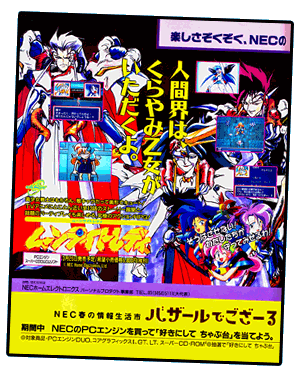
Moonlight Lady Poster #1. SOURCE: Gekkan PCE #3 (1993 March)
Moonlight Lady Poster #2. SOURCE: Gekkan PCE #4 (1994 April)
Merely glancing at the ads reveals the stark contrast in marketing strategies: (A) the first ad focuses exclusively on the game's three female protagonists—à la High School Charlie's Angels—providing scant information on the actual game itself; (B) the second ad provides screenshots of actual gameplay and prominently displays character art of villains to emphasize the conflict and drama of the game.
CREEPY, QUANTIFIED: The first ad literally focuses entirely on the trio of young girls. Since the girls are 15 years old, it is creepy that their measurements—(B)ust, (W)aist and (H)ips—are given such prominence in each of their bios…
METRIC SYSTEM: The measurements are in centimeters.

ARTEMIS…
Born: 06.01.1977 (15 years, 9 months*)
Blood Type: O
T: 160 B: 83 W: 56 H: 83
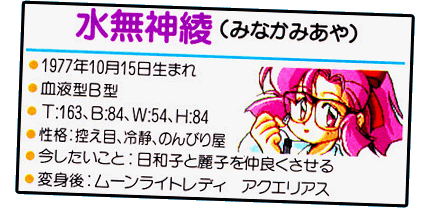
AQUARIUS…
Born: 10.15.1977 (15 years, 5 months*)
Blood Type: B
T: 163 B: 84 W: 56 H: 84
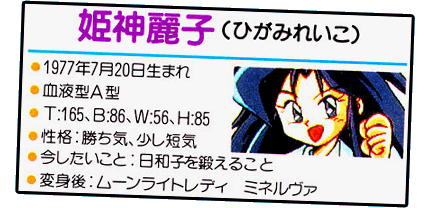
MINERVA…
Born: 07.20.1977 (15 years, 8 months*)
Blood Type: A
T: 165 B: 86 W: 56 H: 85
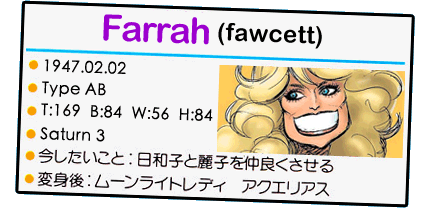
FARRAH…
Born: 02.02.1947 (45 years, 2 months*)
Blood Type: AB
T: 169 B: 84 W: 56 H: 84
*NOTE: The release date for Moonlight Lady (03.26.1993) was used to calculate each character's ages.
REAL-LIFE ANALOGUE: In the name of science, I have tried to find a real-life analogue for the protagonists in Moonlight Lady. Believe it or not, Artemis, Aquarius and Minerva are, essentially, shorter versions of Farrah Fawcett (T: 169 B: 84 W: 56 H: 84). Of course, Farrah Fawcett was 30 years old when Artemis, Aquarius and Minerva were born. And she was 45 years old when Moonlight Lady was released.
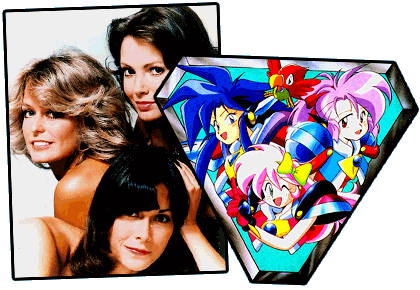 KETSUEKI-GATA: You may have been surprised to see each girl's blood type listed in their bios. Why list this, you ask? Ketsueki-gata is the belief that a person's blood type is predictive of one's personality, temperament and compatibility with others. It has as much scientific validity as astrology (that is, nil), so I won't waste much time with it.
KETSUEKI-GATA: You may have been surprised to see each girl's blood type listed in their bios. Why list this, you ask? Ketsueki-gata is the belief that a person's blood type is predictive of one's personality, temperament and compatibility with others. It has as much scientific validity as astrology (that is, nil), so I won't waste much time with it.
A DIFFERENT KIND OF CREEPY: The second ad, thankfully, is less "pervo-creepy" (no breast measurements of high school girls) and simply "normal-creepy" (the cast of enemies are scoundrels, surely, with sinister stares and devilish smirks). This character art—highlighting the sinister cast of enemies facing our heroines—effectively emphasizes the potential conflict and drama in Moonlight Lady.
TELEVISION COMMERICAL: The non-creepy television commercial for Moonlight Lady followed a predictable formula of Girls!–in a cute ARPG! (a third approach to marketing).
FINAL VERDICT: I am guilty of nit-picking these two ads for Moonlight Lady, but the truth is that the actual game is a cute ARPG with nice character designs, polished cinemas, and…not pervo-creepy at all.
MAGICOAL (SCD)…▲
As far as I know, Magicoal does not prominently advertise the (B)ust, (W)aist and (H)ip measurements for the game's cast of characters, automatically making it less pervo-creepy than Moonlight Lady Poster #1.
WIZARD PROTAGONISTS: Melvy (green sceptre) and Rhun (red sceptre)…
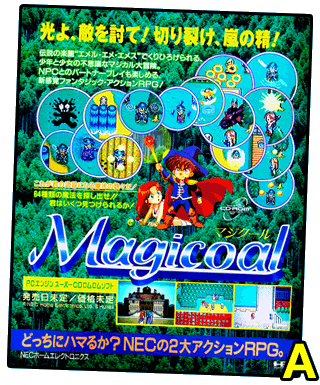
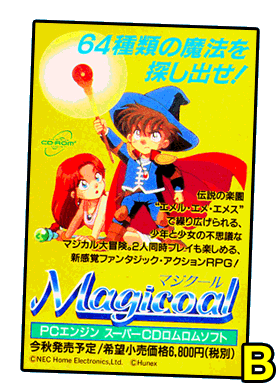


(A) Magicoal Ad #1. SOURCE: Gekkan PCE #03 (1993 March)
(B) Magicoal Ad #2. SOURCE: Gekkan PCE #10 (1993 October)
(C) Magicoal Ad #3. SOURCE: Gekkan PCE #08 (1993 August)
(D) Magicoal Ad #4. SOURCE: Gekkan PCE #11 (1993 November)
TINY ADS FOR NINE MONTHS: Interestingly, NEC's marketing department felt that only (A) the first Magicoal ad warranted a full-page—subsequent advertisements (over eight months) ranged in size from ¼ to ½ page (B & C, respectively). Spanning across the bottom of two pages, (D) Magicoal Ad #4 is roughly equivalent to ¼ page.
Q: What was the ultimate result of this "tiny ad" campaign?
A: During 1993, NEC did not allow anyone in Japan to forget about Magicoal, since it shared ad space with several top-tier games (Street Fighter II', Legend of Xanadu, Emerald Dragon) over a period of nine months leading up to Magicoal's release (10.29.1993). The ads for Magicoal may have been tiny, but you could not escape from them. Contrast this with NEC's strategy for Moonlight Lady: two, successive, full-page ads just prior to the game's release (03.26.1993)…perhaps this approach was more impressive than a series of tiny ads?
HACKNEYED: The art used in all three ads is clichéd (why should Melvy, the female wizard protagonist of Magicoal, be sprawled on the ground in a vulnerable position whilst her male partner, Rhun, holds aloft his sceptre with impunity? Why not have Rhun helpless on the ground and Melvy protecting him?). Magicoal is unusual in that it offers 2-player co-op, so Melvy should kick as much, if not more, butt than Rhun. Given the 2-player co-op mechanics, a perfect opportunity to flip gender expectations was squandered. Sexist gender roles aside, though, both Rhun and Melvy are cute as hell. It is impossible to deny this fact.
Continued below…
WORK IN PROGRESS…▲
Work in progress…

DETAIL: …
Note the…
▲
Return to top of page…